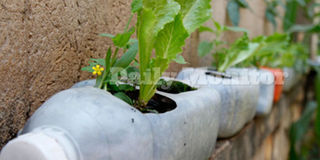Prime
Steps to get the most from a backyard garden

While doing backyard gardening, use paper bags, sacks, used containers and old car tyres since they can hold soil. PHOTO/FILE/RACHEL MABALA.
Backyard gardening is one of the most preferred hobbies by people who live in urban setting, since it gives them an opportunity to vent their farming passions. But these pastime gardens can be managed in a way that they produce enough yields not only to support a family kitchen and cut the costs of visiting the green groceries, but also earn the owner a small income.
The following is a three-step programme to increase yields from your backyard garden according to Carol Mutua, an expert from Egerton University’s department of Crops, Horticulture and Soils.
Weeding and watering
Watering is critical during the dry season where one should ensure their garden is watered twice a day, preferably in the morning and evening.
However, weeding calls for much more attention since it’s a key determinant factor of the volumes of harvest. “It can be done culturally which involves the manipulation of the environment to suppress the growth of weeds and promote growth of plants which involves mulching, cover cropping, early planting and proper spacing,” Mutua explains.
Proper use of manure
This is the best form of additive in a backyard garden given the fact that the quantities needed are very small, Mutua explains.
“Sometimes you find there is chicken or other livestock in the compound which means the manure will be readily available,” the expert says. “It’s one of the most affordable and easiest ways of increasing the soil fertility of a backyard garden”.
Crop rotation
Different crops need different soil nutrients to thrive and interchanging them, Mutua says, gives the backyard garden space to regenerate a particular nutrient. “This should be done in a manner informed by expert knowledge of the nutrients needs of every plant,” she explains.
“Shallow rooted crops such as cabbages and carrots should be alternated with deep rooted ones in a garden such as maize, sugarcane and bananas,” she says.
She says while crops from the same family such as Irish potatoes and tomatoes should not follow each other in a backyard garden rotational scheme, it’s important to always include legumes like groundnuts or peas to improve soil fertility.




